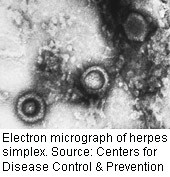
TUESDAY, April 12 (HealthDay News) — People with genital herpes can transmit the virus to partners even when they do not have lesions, new research shows.
Although this has been suspected before, “the data here looks really robust,” said Fred Wyand, a spokesman for the American Social Health Association.
Herpes simplex virus type 2 (HSV-2) infection is one of the most common sexually transmitted diseases, affecting some 536 million people worldwide. Sixteen percent of U.S. adults have tested positive for HSV-2, but only 10 percent to 25 percent of those infected recognized the disease.
Blood tests to detect HSV-2 became widely available in 1999, making it easier for people to find out if they have genital herpes even if the infection isn’t active.
Still, previous large government surveys had found that some 80 percent of Americans don’t know they have genital herpes, said study co-author Dr. Christine Johnston. The report appears in the April 13 issue of the Journal of the American Medical Association, a themed issue on infectious diseases and immunology.
“Most people don’t know they have it,” Wyand said. They may even have symptoms, but not recognize what they are.
“They could be mild symptoms or they may attribute it to something else: chafing, jock itch, yeast infections,” he explained.
Researchers had also known that people don’t have to have symptoms to transmit the virus.
The current study is the largest yet to look at the issue and also used a sensitive DNA test to detect the virus “meaning we were able to give a much clearer estimate of how often people shed,” said Johnston, who is acting assistant professor of medicine at the University of Washington in Seattle.
Shedding refers to when the virus is replicating and therefore is transmissible to another person.
The trial involved almost 500 people who had tested positive for the virus. Each person took daily genital swabs for at least 30 days. More than 28,000 swabs were collected and analyzed.
The virus was detected on 20 percent of days in 410 people who had symptoms, compared with 10 percent of days in those who had no obvious symptoms.
But both groups shed about the same amount of virus on the days they were shedding.
“The main difference was the time,” Johnston explained.
The findings argue for use of preventive measures as often as possible. Those include wearing a condom, taking the antiviral medication Valtrex (valacyclovir) every day and telling your partner about the infection.
“All of those three strategies have been shown to reduce transmission by 30 to 50 percent,” Johnston said. “Thinking out all of those strategies and utilizing those should be considered.”
More information
The U.S. Centers for Disease Control and Prevention has more on genital herpes.

